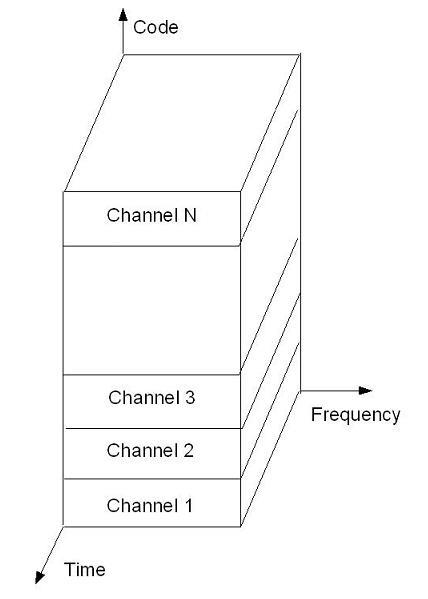Code Division Multiple Access
Code Division Multiple Access
In CDMA, the same bandwidth is occupied by all the users, however they are all assigned separate codes, which differentiates them from each other. CDMA utilize a spread spectrum technique in which a spreading signal (which is uncorrelated to the signal and has a large bandwidth) is used to spread the narrow band message signal.
Direct Sequence Spread Spectrum (DS-SS)
This is the most commonly used technology for CDMA. In DS-SS, the message signal is multiplied by a Pseudo Random Noise Code. Each user is given his own code word which is orthogonal to the codes of other users and in order to detect the user, the receiver must know the code word used by the transmitter. There are, however, two problems in such systems which are discussed in the sequel.

Basic concept of CDMA
CDMA/FDD in IS-95
In this standard, the frequency range is: 869-894 MHz (for Rx) and 824-849 MHz (for Tx). In such a system, there are a total of 20 channels and 798 users per channel. For each channel, the bit rate is 1.2288 Mbps. For orthogonality, it usually combines 64 Walsh-Hadamard codes and a m-sequence.
CDMA and Self-interference Problem
In CDMA, self-interference arises from the presence of delayed replicas of signal due to multipath. The delays cause the spreading sequences of the different users to lose their orthogonality, as by design they are orthogonal only at zero phase offset. Hence in dispreading a given user's waveform, nonzero contributions to that user's signal arise from the transmissions of the other users in the network. This is distinct from both TDMA and FDMA, wherein for reasonable time or frequency guard bands, respectively, orthogonality of the received signals can be preserved.
CDMA and Near-Far Problem
The near-far problem is a serious one in CDMA. This problem arises from the fact that signals closer to the receiver of interest are received with smaller attenuation than are signals located further away. Therefore the strong signal from the nearby transmitter will mask the weak signal from the remote transmitter. In TDMA and FDMA, this is not a problem since mutual interference can be filtered. In CDMA, however, the near-far effect combined with imperfect orthogonality between codes (e.g. due to different time sifts), leads to substantial interference. Accurate and fast power control appears essential to ensure reliable operation of multiuser DS-CDMA systems.
